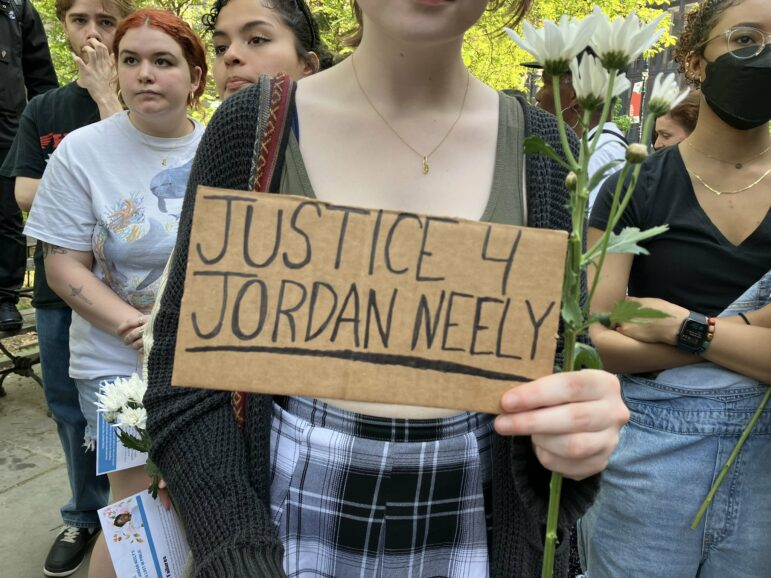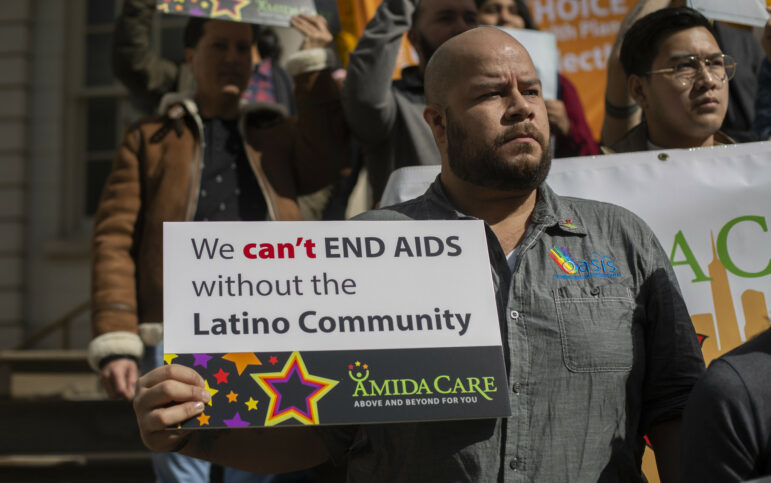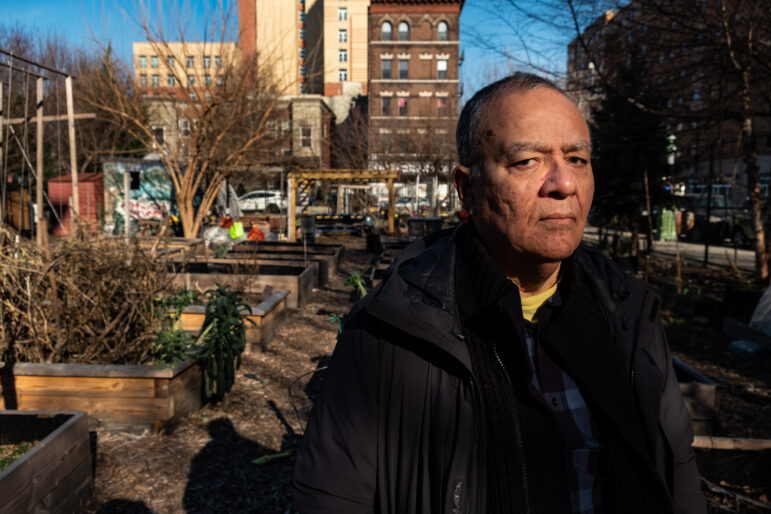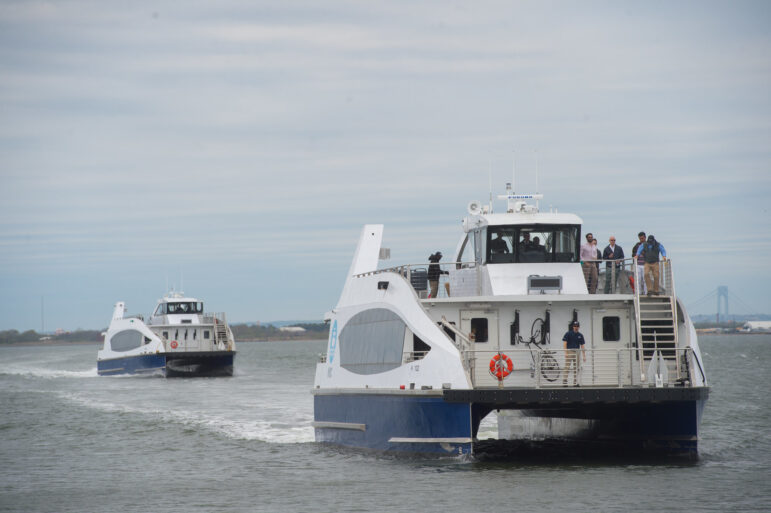“Our lives were here, all of our close friends, everything we had done for years and years,” said former New York City resident and veteran Ramond Curtis. “We absolutely would have stayed if we could have invested in our home in some way, even if it was a co-op, even if it was affordable rent options.”

Adi Talwar
Marine Corps Veteran and housing advocate Alex McCoy with his wife and daughter in their apartment in Harlem.The number of veterans living in New York City has dropped by nearly half over the past decade, for myriad reasons—including declines in military enlistment numbers and an aging population.
But another factor that’s driven some veterans from the five boroughs, according to experts and advocates who spoke with City Limits: cost of living, as former service members struggle to find affordable housing and use their hard-earned benefits.
The most recent 2023 American Community Survey data, made available last week, indicated the city’s population stands at 1.7 percent veterans, compared nationally to a little over 6 percent. The numbers show a 49.9 percent decline in the city compared to 2013, while New York State as a whole lost 29.9 percent of its veteran population.
While the decline can partly be attributed to aging veterans passing away, it also underscores the increasing difficulty veterans face in affording life in New York City and fully utilizing their housing benefits here compared to other states.
This comes despite the city effectively ending chronic veteran homelessness in 2015 under the de Blasio administration—an achievement that fails to account for those who are housing insecure, sources told City Limits.
“At that time, there was a lot of federal resources coming into localities, mostly in the form of the Section 8 vouchers called HUD VASH vouchers,” said Tori Lyon, CEO of Jericho Project, a New York City nonprofit focused on ending homelessness by offering supportive housing, job opportunities, and health services to those in need, including through dedicated housing for veterans.
The Housing and Urban Development-Veterans Affairs Supportive Housing (HUD-VASH) program is a joint effort by the U.S. Department of Housing and Urban Development (HUD) and Veteran Affairs (VA) to provide homeless veterans with rental assistance and supportive services, and saw significant expansion during the Obama administration.
“They just invested a lot of money, and cities took account,” said Lyon. “It was a huge success, but it was a lot of city resources, and since then, there’s just been so many other crises.”
A tale of two veterans
Outside of the city's effort to keep veterans housed through HUD-VASH and other programs, a bigger factor at play is one that many non-veteran New Yorkers are feeling as well: a lack of affordable housing.
“I think what the conversation is often missing is we focus so much on homelessness, and that’s obviously very important, but what we often forget from a policy-making perspective is people will do anything in their power to avoid falling into homelessness in the first place,” said Alex McCoy, a 36-year-old Marine Corps veteran and advocate with Open New York, a non-profit advocating to increase the city’s housing supply.
“What that means in practice is, as housing becomes unaffordable, my peers leave the city,” McCoy said.
A 10-year resident, McCoy originally moved to New York at the end of his enlistment to attend Columbia University and earn his degree using his GI Bill educational benefits. But since graduating, he has had to move numerous times, largely due to rising rents.
With the birth of his first child in March, he and his wife, now living in West Harlem, have been struggling to find a suitable home they can afford in the city despite both of them working.
“It's where I consider home. It's a city that I love and would like to stay in,” said McCoy. “We're not poor, but we're not high earners either, and it's been challenging to find a stable housing situation that has space for our growing family and our ambitions.”
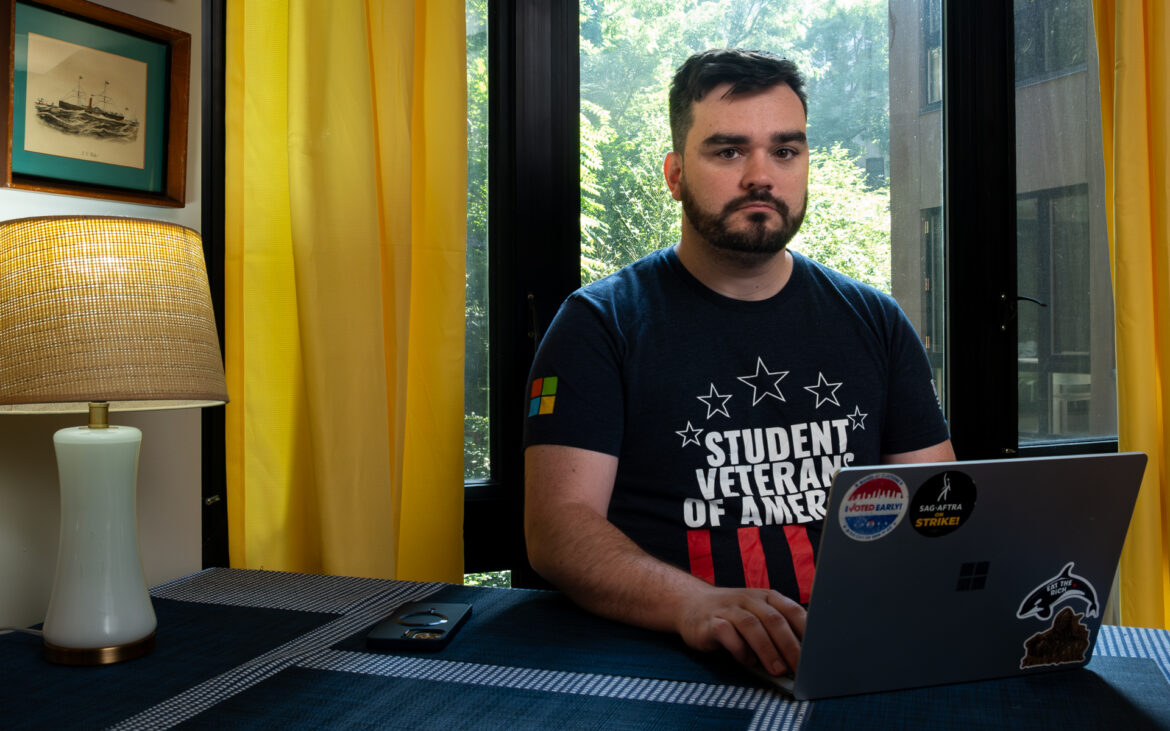
Adi Talwar
"As housing becomes unaffordable, my peers leave the city,” Marine Corps Veteran Alex McCoy told City Limits.Many senior or disabled vets also need accessible housing, compounding the already difficult task of finding a home. McCoy is disabled himself, having suffered lung damage during his service that at times causes difficulty breathing.
“I really need to not be in a high-up walk-up. I need to have an elevator building,” he said.
Other veterans who once cherished living in New York City have opted to move elsewhere, seeking better housing opportunities where their VA Home Loan—a long-standing and significant benefit for service members—can be more effectively utilized.
Ramond Curtis,* an Army National Guard veteran who served from 2003-2009, came to the city following his service to take advantage of his education benefits and attend school. He met his life partner here, graduated from Columbia with a bachelor's degree in political science and eventually got a job at a veterans non-profit based in Washington, D.C., working remotely.
“At the time, I thought, this means I'm going to make it. This means we're going to be able to have the life that we want,” said Curtis.
For a while, Curtis and his partner rented and heavily renovated, at their own expense, a converted warehouse apartment in Brooklyn with extra rooms they sublet to supplement their expenses. But before long, they wanted to start building equity and buy a home of their own to foster kids and start a family, but found it nearly impossible in the city.
“Even though we paid off our credit card debt so that we could have a credit score that would allow us to get a VA loan, it didn't matter because there was no VA loan that could afford us something in the city or any of the boroughs, at least, not in a neighborhood where we would want to raise a family,” Curtis said.
“It’s fun here. There’s lots of stuff to do. We have friends here,” he added. “But we can’t start a life here. We can’t buy a house.”
When the COVID-19 pandemic began and Curtis’s partner was laid off from his local job, moving out of the city “became the obvious choice,” he said. After spending over a month house hunting, Curtis took out a VA Home Loan and closed on a 3,000-square-foot house on a half-acre of land in Harrisonburg, Virginia, in the Shenandoah Valley, where they now foster their two kids.
Despite their reluctance to leave, the move had the desired effect for Curtis and his new family.
“Moving out of the city changed everything. It made it from where we weren’t sure we’d be able to get an apartment on our own to, we can start a family in a home and a life and invest in our own future,” he said.
Room for improvement
Originally created in 1944 under the GI Bill, The VA Home Loan was designed to help World War II veterans buy homes following the war. It works by providing a government guarantee to private lenders, which reduces their risk and allows them to offer favorable terms, like no down payment and no private mortgage insurance. If a borrower defaults, the VA covers part of the loan, making it easier for veterans to get financing.
However, veterans in New York City often face challenges utilizing this benefit due to the city’s high property prices and a competitive housing market that favors cash buyers or conventional loans. Additionally, the prevalence of condominiums, which require VA approval, and a general lack of awareness about VA loans among real estate agents and sellers further complicate the process for veterans..
These challenges, compounded in recent years by high mortgage rates and low inventory following the pandemic, have also impacted the number of veterans utilizing the loan. A Freedom of Information Act (FOIA) request to the VA revealed a 65.4 percent drop in the number of loans disbursed in New York City from 2015 to 2023 and a 43.6 percent decline in the state overall.
While it may be some time before the housing market begins to cool down, one possible path to veteran homeownership in the city comes in the form of a federal bill known as the Fair Access to Co-ops for Veterans Act. If passed, it would modify the current VA Home Loan so that it could be used to purchase a cooperative apartment, currently ineligible under the program.
Seeking to revive a similar pilot program that existed from 2006 to 2011, the bill was introduced to the House of Representatives in March with bipartisan sponsorship from Representatives Grace Weng and Nicole Malliotakis of New York’s 6th and 11th districts, respectively.
“With co-ops accounting for roughly a quarter of the housing market in New York City, these units offer many New Yorkers the opportunity to own property and build equity,” said Rep. Malliotakis in a statement. “It is critically important that we ensure our veterans, who have sacrificed so much for our nation, have access to this housing.”
In May this year, members of the City Council’s Committee on Veterans introduced a resolution calling on Congress to pass the bill.
“There is more co-op housing located in New York than any other city, and then we have lower rates for veterans, not only in homeownership but many other categories,” said Councilmember Robert Holden, who chairs the committee and sponsored the resolution. “I think it's a win-win for everyone.”
Of course, the impacts of the city’s housing shortage stretch beyond just veterans. A report published by the Fiscal Policy Institute in June found that 90 percent of New York State’s population loss is driven by New York City, and that more than a third of households moving out of New York are doing so in search of more affordable housing.
Mayor Eric Adams’ administration says it wants to address the crisis with its City of Yes for Housing Opportunity initiative, which would allow for “a little more housing in every neighborhood” by easing many standing zoning restrictions so developers can build more homes.
“We need citywide and statewide solutions that hold all neighborhoods accountable, especially with the highest resources and the most support to building more homes,” said Annemarie Gray, the executive director of Open New York. “That is the only way we ensure that we are giving marginalized groups the ability to have a stable, dignified place to call home and be able to live in New York City.”
The initiative is currently in the end stages of the public review process, and is up for a City Planning Commission vote on Wednesday before it heads to the City Council. Community boards have been split on the plan—more than two dozens have weighed in unfavorably outright—with critics citing concerns about lack of affordability mandates, potential impact on neighborhood character and allowing more as-of-right density without local review.
But McCoy thinks it’s the right move. Last year, the city’s rental vacancy rate was just 1.4 percent, the scarcest availability in several decades.
“The solution for veterans in the city is the solution for everybody. We need programs like the City of Yes,” said McCoy.
“The only way we would be able to take advantage of our VA home loan and become homeowners or property owners is if the costs of houses and co-ops and dwellings go down, and the only way to make that go down is to build more.”
This story was produced as part of the Military Veterans in Journalism Fellowship, a partnership between Military Veterans in Journalism (MVJ), the Institute for Nonprofit News (INN), and the Craig Newmark Graduate School of Journalism at CUNY.
To reach the reporter behind this story, contact Chris@citylimits.org. To reach the editor, contact Jeanmarie@citylimits.org
*An earlier version of this story included a typo in Curtis' first name. City Limits regrets the error.
Want to republish this story? Find City Limits’ reprint policy here.


